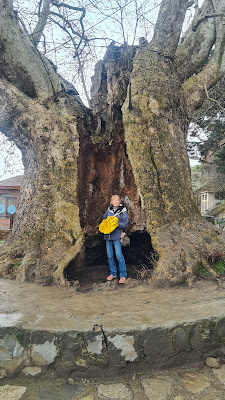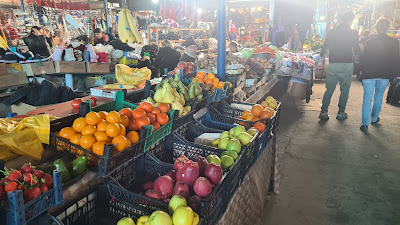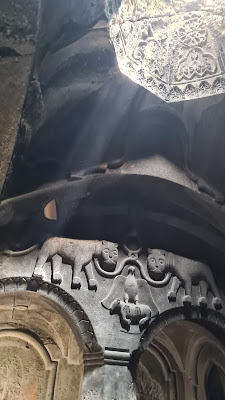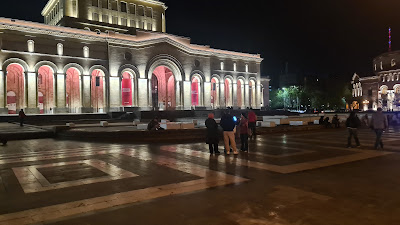 |
| Inside the Church of Prince |
Giorgi was not only a competent driver for these roads, which are not as disciplined as elsewhere, but was also an extremely knowledgeable guide and very personable company. We warmed to his company and learned much about him as the trip progressed - second language German, but his English was excellent too, and he would later demonstrate the value of having Russian at his disposable. He is extremely fit and does lots of hiking, climbing and such adventure pursuits.
It was my 77th birthday and I was surprised at breakfast with a cake from the hotel with cards, those that had arrived before we left and Jean had brought, and a present! It is a local product of nuts encased in a sort of gelatine, formed into the shape of a candle. Hugh & Tammy selected three in the colours of the Irish flag - green, white and gold, highly befitting my other passport!
 |
Churchkhela
in the colours of the Irish Tricolour |
Then it became time to leave Tbilisi and take to the Georgian Military Highway, so named from >200 years ago because of what it was for and by whom it was built. We had several stops along the way, crossed over some high passes, peaking at about 2,400m, and were lucky enough to get past queues of trucks bound for the Russian border. They were being stopped and then released in blocks by the Police. When we passed through old Soviet era single lane tunnels on the other side, it was evident that they were too narrow for a truck and a car, barely two cars, never mind two trucks!
 |
Loading up our Mitsubishi Delica
We fitted in, just! |
 |
Ananuri Fortress Complex
first stop on the Highway |
 |
Overlooking the Zhinvali Reservoir
very low |
 |
| Climbing towards the snow |
 |
| Trucks heading (slowly) for Russia |
When we encountered the queue, we were able to make good progress overtaking, fortunately little to no traffic coming the other way, and the truck drivers seemed to allow a space for any of them to pull in.
But, it didn't last forever!
 |
| Now queued |
We had truly climbed into the snow by now.  |
More trucks waiting where we stopped for coffee
at the Gudairi ski resort, at around 2100m |
Nestled in the Jvari (Cross) Pass, we stopped at the Russian-Georgia Friendship Monument, just beyond the ski resort.
 |
| Russian-Georgia (so called) Friendship Monument |
Giorgi explained that it was 'so called' because of the pretentiousness of friendship in a fractious relationship, purported by the Russians but depicted with art that portrayed that contradiction in a clever and subtle way that had to be looked for in the paintings.
 |
| Rooms Hotel Stepantsminda |
It was definitely the right and best place to stay, with a terrific view over the valley, up to the Gergeti Trinity Church on a peak opposite and the Kazbegi Mountain beyond, even if it did have the look of a prison (credit Giorgi) from the outside! It was way too hot inside and had large tables in the restaurant that were shared with others, and it was noisy! That sounds a rather conflicted review, but it was the right place nonetheless!
 |
A dinner birthday celebration with
Gergeti Trinity Church
lit and visible on the hillside behind |
And there was even a birthday cake here as well to celebrate!
 |
| Medok Honeycake with candle |
 |
Sno [sic] Valley carved heads
near Stepantsminda |
 |
Terek Valley
falling towards the Russia border |
 |
Dariali Monastery
by the Russian border |
 |
Russian border at the
narrowest gorge of the valley |
It is a little difficult to see the detail because of all the clutter in the image, but it was as close as we could get looking down on it from the Monastery. It is in a very narrow gorge in the valley.
 |
An almost invisible hillside
settlement overlooking the border |
Here, small numbers of villagers in earlier times used to be able to defend against battalions of invaders.
 |
| Terek valley highway below |
 |
An avalanche almost blocks the
access road up to Gergeti church |
 |
Gergeti Trinity Church
the last bit a walk |
 |
Layered stone formation
on the final ascent up to the church |
 |
Looking down on Stepantsminda
from the church |
 |
| The final ascent to the church |
The weather had continued mostly kind although temperatures were considerably colder in low single figures. Rain was to make an appearance the following day as we returned over the Jvari Pass heading back towards Tbilisi before turning east towards the wine country and Sighnaghi.
 |
Kazbegi Mountain
across from Rooms Hotel
about 4,000m |
 |
Heading back over
Jvari Pass |
 |
| Weather had turned murky and damp |
 |
| Trucks queuing again |
 |
| Korbuda Restaurant |
Near to Pasanauri village, we called into the Korbuda Restaurant to sample some khinkali, a traditional Georgian dish that originates from this area. The original is minced lamb boiled in a dough casing and has to be eaten upside down, holding the central fold, occasionally sucking out the juice to avoid spillage! They were delicious and we added the simpler cheese one as well. |
Georgi talks through the places we will visit
while we wait for the khinkali |
 |
The restaurant had a great mix of
rustic finishes and styles, inside and out |
 |
Meat and cheese khinkali
Giorgi demonstrates how to hold it |
 |
And a local beer
finishes it off nicely! |
We then travelled onward to Tevali for a walkabout before heading onwards for Lost Ridge Ranch in Sighnagi in the Kakheti Wine Region, in the east of Georgia.
 |
Tevali
a mix of buildings, some ugly Soviet ones,
but they are trying to restore in the traditional style |
 |
King Erekle II statue Tevali
Monarch of Kakheti 1744-1762 |
 |
Giant Plane Tree
Tevali |
 |
Schuchmann Winery near Tevali
Clay pots fermenting wine
below ground level |
The winery makes Georgian wines in the traditional manner where the fermentation takes place in buried clay pots. It also makes sparkling Chardonnay, which is secondary fermented and riddled while bottled in the traditional French way. The bottle neck is then frozen for the yeast plug to be removed before final capping of the bottle. |
| Saperavi red wine maturing in barrels |
 |
| Riddling racks |
 |
The finale and the time
for tasting finally arrives! |
 |
Two whites (amber)
and a red |
 |
10 in the left + 2 in the right
Impressive! |
 |
Lost Ridge Ranch
& Craft Beer Brewery |
 |
Time for tasting
Black IPA & Hazy IPA |

We met the Brewmeister, a young American from California, who works at a couple of craft breweries and he clearly knew his stuff when responding to a question about lager making from Hugh.
 |
Dinner at the Ranch Restaurant
a shortcut walk away, but with our return in the dark
after an onboarding of some fine Saperavi red
using mobile torches meant getting a tad lost! |
 |
| A patient plea to share dinner! |
During a rather damp day with limited visibility of the wonderful hills and views, we toured the Bodbe Monastry aka Convent of St Nino, where a huge and very impressive new Monastry is nearly complete alongside it.
 |
| Old Covent |
 |
New Bodbe Monastry
alongside |
 |
Waiting for Giogi to pick us up
at the bottom of the path
down to the Holy Spring |
 |
One of the many friendly
but tagged roaming dogs |
 |
| Sighnagi, town on the hill |
 |
| Russian Lada |
There were some Ladas in Georgia. |
| Monument to the Fallen |
 |
| City Wall |
 |
Beware
Rainwater is just directed
out into the middle of the road! |
 |
| Georgi on the city wall |
 |
The City Wall encompassed a huge area
Just visible on the hilltop opposite |
 |
Jean meets another dog
on the City Wall |
Then it was time to load up and head towards the Armenian border, near Sadakhlo, with a few stops along the way, including a wander around a local market.
 |
| Loading up again |
 |
Cheeses
We discovered some are quite sour |
 |
| Chickens |
 |
| More churchkhela |
 |
Still not sure what this
dried something was! |
 |
Goodbye Georgia
Hello Armenia |
The crossing was surprisingly quick and easy although we did have to take our luggage out for a cursory x-ray on the Armenian side. While waiting for Georgi to clear his vehicle paperwork, we saw a mother with her pups under a small tree.
On route to our first stop, Dzoraget, in Armenia, we visited two monasteries. |
Haghbat Monastry
976AD |
We climbed, from alongside a river and mining town, into the hills and made our way through a township with lots of Soviet era housing and architecture, to the next monastery. |
| Mining town below |
 |
Soviet era housing
built in 'tuff', a soft rock
that is formed from liquified volcanic ash |
 |
Sanahin Monastry
966AD |
 |
More engraved pictures
on headstones |
 |
| In need of some refurbishment?! |
Then, it was onward to Dzoraget, and a one night stop by the river.
 |
Tukfenkian Avan Dzoraget Hotel
|
Unfortunately, Jean had a mishap inside this hotel when she tripped on a stone staircase. She was lucky to escape more serious injuries, but had to visit a hospital. The hotel staff were great and crowded round with help and, in the end, we decided to take her with us as we would be passing through the town with the nearest hospital.
Heading further south, we went to the Vanadzor Medical Centre, where Giorgi's Russian came to the fore. There was a consultation and x-rays, after which Jean was found to have broken her little finger, sprained her ankle and had a goodly size bump on her head. Giorgi remarked that the doctor she saw was really caring and comforting while he plastered her finger and fitted an elasticated bandage to her ankle, giving me instruction on how to do it again. He also declined payment for his services, the other costs of the treatment and some painkillers was miniscule, and whole process took little more than an hour! Jean, bravely, stayed in the van for the rest of the day as we continued onward.
Heading east, we stopped briefly at the small town of Dilijan.
We met 4 young Jordanian female medical students having a picnic in the covered seating to the right above, to celebrate the end of Ramadan. They were very friendly and gave us each a banana and a chocolate bar!
 |
A curious conversion!
'Be Blessed' |
Turning to the southwest, it was onward to Yerevan, capital of Armenia, and the Tukfenkian Heritage Hotel in the old town.
 |
Carpet weaving machine
takes centre stage
in the dining room |
 |
Carpet shop beside
the restaurant |
The hotel were great on our arrival, finding Jean an office chair with wheels to get to the room, and she kept it for the rest of the stay. She rested up to allow recovery, had to rely on room service, and was unable to enjoy the quirky restaurant with its carpet machine and adjacent carpet shop. But the hotel room was comfortable.
Exploring Yerevan by road was hampered by heavy traffic, double parking and difficulty finding spaces to do so. It definitely a greater Soviet feel about it - more brutal Soviet architecture in and amongst less attractive other buildings, when compared to Tbilisi. This results from the still close ties with Russia, including a garrison of Russian troops in the nearby city of Gyumri, northwest of Yerevan.
Armenia has been invaded, bullied and bloodied over the centuries, losing much of its land and many of its people have fled, creating a bigger diaspora than its current population of just 3 million. It used to stretch from the Mediterranean to the Caspian Sea, but is now much smaller and is landlocked with troubled borders to both Turkey and Azerbaijan to the west and east. It borders Georgia to the north and Iran to the south. Additionally, the enclave of Nagorno-Karabakh that is within Azerbaijan but is mostly populated by Armenia has been the subject of recent oppression from Azerbaijan, causing more to flee this internationally disputed territory.
Befittingly, we toured the Genocide Museum, which covers two such events, the first in the late 19th century, the second and bigger one under the umbrella distraction of WWI. The Turks set out to eliminate the Christian Armenian people, many losing their lives.
 |
Trees of remembrance & recognition
from families, representatives and leaders
of countries (except Turkey, who deny it) |
 |
| Genocide Memorial |
 |
| Genocide Museum Entrance |
Inside there was a well presented chronology of the Armenian Genocide and, needless to say, it did not make good reading.
 |
Mount Ararat
not far in the distance
but inside Turkey |
 |
| Looking down on Yerevan |
 |
Memorial to the 50th Anniversary
of the October Revolution in 1917
that led to the formation of the Soviet Union |
Heading east from Yerevan into the hills provided a great view in clear conditions of Mount Ararat, where Noah beached his Ark.
 |
A clearer day and
view of Mount Ararat |
 |
Garni, high above Yerevan
surrounded by deep gorges |
 |
Garni Temple, part of
Garni Historical & Cultural Museum |
Garni Castle fortress was built around the 2nd century BC, but little of the fortress remains. The temple is the only surviving pagan temple, predating Christianity in Armenia, and was originally built in 77AD. In the 4th century when Christianity was adopted, all other pagan structures were destroyed, but Garni was spared. However, it collapsed in an earthquake in 1679. After many ideas and plans to remove the stones and reconstruct it elsewhere, the temple was finally put back together in the late 1960s after Soviet approval.
Alongside the temple were a bath house with mosaic floor and other palatial buildings.
 |
| Bath house |
 |
| Fountain dedicated to the reconstruction |
 |
The gorge leading to the
'Symphony of Stones' |
 |
The Symphony of Stones near Garni
is a basaltic formation that
is very similar to the Giants Causeway in NI
but completely dwarfs it! |
 |
Seriously impressive
columns |
 |
| and overhangs |
 |
| Polygon structures |
 |
| This gives scale |
 |
I confess to feeling rather nervous
with so many rock columns above me
and so many cracks showing in them! |
Then, it was onward to another Monastery even though we were getting close to our fill! But, we weren't to be disappointed.
 |
Crosses on the hill at the end
of the valley above Geghard Monastery |
 |
| Geghard Monastery |
Dating from 1215, it is set high in the hills at the end of
a valley and I did wonder how the location had been chosen, accessed, and the construction
achieved in such a difficult location. The monastery was famous
because of the relics that it housed. The most celebrated of these was the
spear which had wounded Christ on the Cross, allegedly brought there by the
Apostle Thaddeus, from which comes its present name, Geghard-avank ("the
Monastery of the Spear"), first recorded in a document of 1250. The spear is now in
the museum of Echmiadzin monastery.
 |
| Ancient pillar inscriptions |
 |
| Partially dug into the hillside |
 |
Giorgi musing
on a milling stone |
 |
A copied khachar
(individual carved stone memorial)
because the originals were
destroyed by Azerbaijanis |
 |
Lady making lavash bread
(thin like a chapati or naan)
at a roadside stop
in a traditional oven |
 |
Stuck to the side,
timing is everything |
 |
Chimney pulled down
over the oven while
it is reheated |
 |
2 Armenia coffees
(thick, strong and gritty)
and some sweet cake |
 |
Fire being replenished
with vine branches |
It became time for our final meal, sadly without Jean, and we walked to a recommended restaurant just off Republic Square nearby.
Well, it was quite a trip to places hitherto unknown. It was so good to enjoy the experience with Hugh & Tammy and be so well informed and cared for by Giorgi.
Georgia and Armenia I found to be quite distinct, but with some overlap inevitably from their shared Soviet eras. There were far more Ladas on the road in Armenia and it looks the poorer and continues to strive for a peaceful independence. This is agitated by Russia by way of soft loans for arms, while Azerbaijan buys its arms from Russia, and no doubt uses them against Armenians in the Armenian enclave of Nagorno-Karabakh, as recently as February this year. This agitation probably keeps Georgia in check in between Armenia and Russia, but by typically disruptive means.
Georgia has moved further away from Russia, but both countries continue to make fine wines with their long history of doing so! They are welcoming and friendly. The food in each tends to a Eurasian fusion with spices used extensively, and they are similar but not identical. Georgian bread, mostly unleavened, is both large and tasty. It also comes packed with meat and other savoury fillings in the many bakeries.
 |
| Georgian Bread |
Armenian bread is mostly lavash, which is thin like a tortilla or naan, and is less suited to mopping up nice sauces! There is some import of other Western cuisines (pizzas for example) creeping into their menus in common with trends in other countries, which is a pity although inevitable. Sharing dishes is the norm in both and we found the food good and enjoyable everywhere, even if it was a bit tepid by the time in made the table, or didn't arrive all together, in some cases. Georgian beer was enjoyed, but I didn't get a chance to compare Armenian beer with it.
Jean was sadly denied some of the sight-seeing because of her tumble, which was a huge shame, but checks back here showed that the diagnoses made in Vanadzor were correct and there were no other issues, which was a great relief. She continues to be looked after by Lorna.
Lastly, I remembered to investigate where I might find some Georgian or Armenian wines and here we go - Amazon among other specialist dealers!













































































































































































































































































































No comments:
Post a Comment